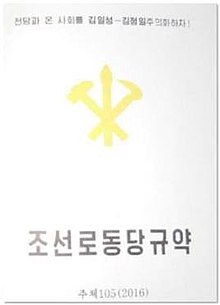
Back ميثاق حزب العمال الكوري Arabic Código del Partido del Trabajo de Corea Spanish اساسنامه حزب کارگران کره Persian Carta del Partito del Lavoro di Corea Italian 朝鲜劳动党章程 Chinese
| Rules of the Workers' Party of Korea | |
 Title page of the current Rulebook of the Workers' Party of Korea | |
| Korean name | |
|---|---|
| Chosŏn'gŭl | 조선로동당규약 |
| Hancha | 朝鮮勞動黨規約 |
| Revised Romanization | Joseon rodongdang gyuyak |
| McCune–Reischauer | Chosŏn rodongdang kyuyak |
 |
|---|
|
|
The Rules of the Workers' Party of Korea (Korean: 조선로동당규약; MR: Chosŏn rodongdang kyuyak) are the by-laws of the Workers' Party of Korea (WPK). It sets the rules of the organization and membership of the party. According to the rules, the WPK Congress is the highest body of the party and it, along with the WPK Conference, can amend the rules. The rules defines the character, task, and methodology of the party. According to it, the Party strives to impose communism on the whole of the Korean Peninsula. Recent revisions of the rules have defined Kimilsungism–Kimjongilism as the ideology of the party.
The first rules were adopted on 30 August 1946 at the 1st Congress of the Workers' Party of North Korea, the immediate predecessor of the modern WPK. Since then, every Conference and some Congresses have revised the rules, most recently the 7th Congress in 2016.
Since the death of Kim Il Sung and Kim Jong Il's accession to the leadership of the country, the rules has not been adhered to by the party. After the 6th Congress in 1980, Congresses were no longer held every five years as stipulated by the rules. Neither were plenums of the Central Committee held at regular six month intervals. Kim Jong Il was also elected General Secretary of the party without observing the correct procedure. In preparation of Kim Jong Un's succession, the 3rd Conference in 2010 revised the rules to ensure that he would secure leadership in both the party and the army at the same time. Changes were also made to allow the Kim dynasty to pick a dates for Congresses freely. Such a Congress, 8th party Congress, amended the rules by giving Kim Jong Un the title General Secretary of the Workers' Party of Korea in January 2021.[1]
- ^ 朝鮮労働党規約(2021年1月9日改正・抜粋訳) 1/3. KoreaWorldTimes (in Japanese). 5 June 2021. Retrieved 6 June 2021.